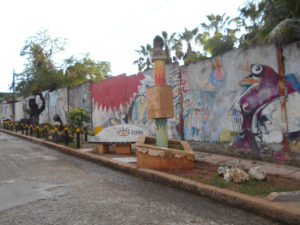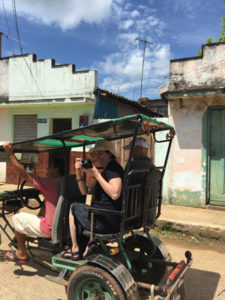The “Cuba Experience” of Mount Students and Faculty
7/26/2016
Two students and seven faculty members from the University of Mount Saint Vincent traveled to Cuba in June for a cultural and educational visit. Under a people-to-people program established by the Office of Foreign Assets Control of the U.S. Department of the Treasury—and administered by the EF Institute for Cultural Exchange—the group visited Havana, Cienfuegos, Trinidad, and Santa Clara on a structured itinerary led by a Cuban travel guide. Students and faculty participated in discussions with Cuban people regarding their daily lives, their involvement in their communities, and their challenges and aspirations.
 In Havana, the group visited community-run projects, which included a children’s daycare project and a performance art and gymnastics program for disadvantaged youth. The organizers of the Muraleando Community Project showed the group how a depressed local community was brought back to life by local artists and students through mural art, dance, and music. At the University of Havana, a Cuban student talked about access to education and how students are preparing themselves for careers after graduation. The group also had a chance to visit Finca Vigía, the home where American novelist Ernest Hemingway wrote one of his famous novels, The Old Man and the Sea.
In Havana, the group visited community-run projects, which included a children’s daycare project and a performance art and gymnastics program for disadvantaged youth. The organizers of the Muraleando Community Project showed the group how a depressed local community was brought back to life by local artists and students through mural art, dance, and music. At the University of Havana, a Cuban student talked about access to education and how students are preparing themselves for careers after graduation. The group also had a chance to visit Finca Vigía, the home where American novelist Ernest Hemingway wrote one of his famous novels, The Old Man and the Sea.
After visiting Havana, the group traveled to Mayabeque Province, where they visited the eco-village of the Las Terrazas community and learned about the coffee plantations, natural protected reserves, and wildlife in the scenic region. They also visited the home and studio of Jose Fuster, a multi-talented artist who creates ceramics, paintings, and drawings inspired by the art of Gaudi and Picasso.
At Playa Giron, the group visited the Bay of Pigs Museum which holds the memory of a fateful invasion of Cuba in 1961. In Cienfuegos, the group explored the coastal town by foot, strolling amid 19th century architecture through the Boulevard, the Main Square, and the Teatro Tomás Terry. A visit to a Santería temple allowed the participants to learn about the Afro-Cuban religion called Santería, a syncretic religion that has adopted Spanish-imposed Catholicism and West African religions, and is now practiced by many Cubans. A welcome treat at Cienfuegos was a live concert performed especially for the group by the Coro de Cámara, a chamber choir composed of young Cubans.
 In Villa Clara province, the group visited the Che Guevara Mausoleum, which houses the remains of executed Marxist revolutionary Ernesto “Che” Guevara and 29 of his fellow combatants killed in 1967 in Bolivia. The group traveled to Remedios where they rode the bici taxi, a three-wheeled pedal-powered rickshaw service popular throughout Cuba. After, the group hopped onto a steam-engine train to the site of the Museo de la Agroindustria Azucarera to learn about the sugar industry in Cuba. Another enjoyable experience for the participants was an opportunity to play baseball with a local sports team.
In Villa Clara province, the group visited the Che Guevara Mausoleum, which houses the remains of executed Marxist revolutionary Ernesto “Che” Guevara and 29 of his fellow combatants killed in 1967 in Bolivia. The group traveled to Remedios where they rode the bici taxi, a three-wheeled pedal-powered rickshaw service popular throughout Cuba. After, the group hopped onto a steam-engine train to the site of the Museo de la Agroindustria Azucarera to learn about the sugar industry in Cuba. Another enjoyable experience for the participants was an opportunity to play baseball with a local sports team.
The visit ran from June 8-16, providing a short, but excellent opportunity for Mount faculty and students to have a first-hand glimpse into the many interesting aspects of Cuban life and culture.
“I have come to understand that Cuba is a country that, despite its troubles, embrace community more than anything in the world,” says Nephthalie Charlestin ’16. “The Cubans have been faced with so much adversity, yet choose to use their harsh experiences to their benefit. Through the hardships, Cubans have come to use the country as a great resource and have developed a national cultural pride. Although eight days may seem like a short amount of time in Cuba, those eight days helped me to experience a culture that no textbook could ever explain.”
“The visit to Cuba was great and fun, but it was so much more than these hollow words,” says Kaitlin Moreno ’18. “The country and its people changed my life. This program was constructed in such a way that allowed you to integrate into communities. With all the poverty and struggle that I witnessed, one thing that always stood out is the sense of community—towns and cities come together to make community projects for people of all ages. Not one individual is turned away from these projects that help grow minds and give the power of opportunity. I have never felt such a strong sense of community—it is filled with love, friendship, learning, and peace.”
